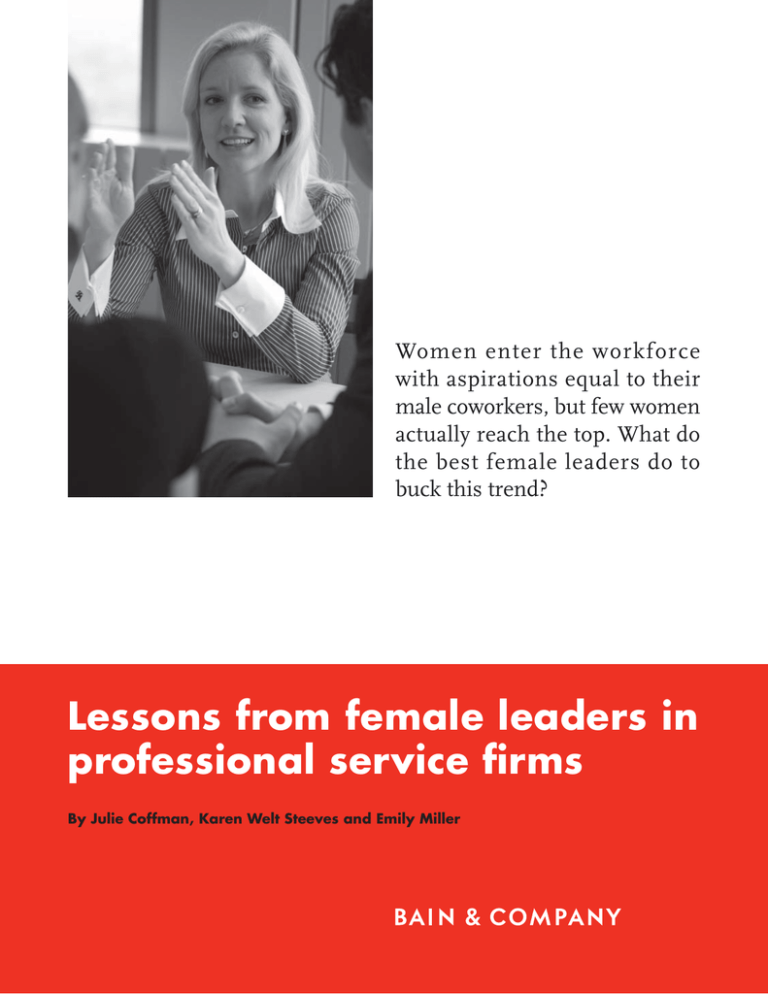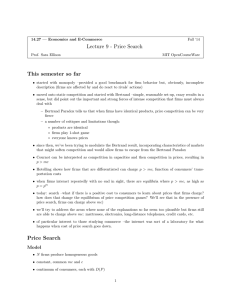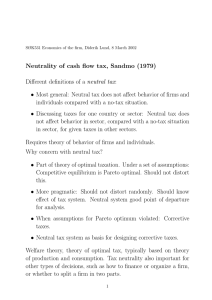
Women enter the workforce
with aspirations equal to their
male coworkers, but few women
actually reach the top. What do
the best female leaders do to
buck this trend?
Lessons from female leaders in
professional service firms
By Julie Coffman, Karen Welt Steeves and Emily Miller
Julie Coffman is a director in Bain & Company’s Chicago office and chair of
Bain’s Global Women’s Leadership Council. Karen Welt Steeves is manager of
Bain’s Global Women’s Leadership Council and is based in Bain’s Boston office.
Emily Miller is a consultant in Bain’s Boston office.
Copyright © 2011 Bain & Company, Inc. All rights reserved.
Content: Global Editorial
Layout: Global Design
Lessons from female leaders in professional service firms
Women enter the workforce with aspirations
equal to their male coworkers, but few women actually reach the
top. What do the best
female leaders do to
buck this trend?
In many respects, professional business services
are a bright spot for women in the workforce.
Women now comprise more than 40 percent of
employees in services such as consulting, finance,
and private equity, far more than in the past. This
trend is likely to continue, since women now earn
more than 50 percent of higher education degrees
in the US.
But few such gains are apparent in the leadership
of professional service firms. Men continue to
dominate the top ranks of nearly every big firm—
fewer than 1 percent of professional services
firm CEOs are women and corporate America
isn’t doing much better—only 7.6% of top
earning positions in Fortune 500 companies
are held by women.1 This gender imbalance in
the executive suites is costing firms money.
Companies that fail to retain and promote
women to top leadership positions experience
a significant drain on resources and talent.
They must bring in new employees to balance
the outflow of women, and they must reach
deeper into the remaining ranks to fill management positions. Perhaps because of such
factors, the benefits of retaining women leaders
are significant. One study found that companies
with the highest female representation in top
management positions achieved returns on
equity 35 percent higher than companies with
the lowest female representation.2
One reason why women fail to reach the top management positions of professional services firms
is that they face a set of challenges not typically
encountered by men. What strategies have the
most successful women adopted to navigate these
obstacles? To find out, we conducted in-depth
interviews with 19 of the most senior women in
consulting, private equity and finance and asked
them this question. These women averaged more
than 15 years of experience in their respective
industries. Sixteen of them held the highest professional title in their firm, and five have served
on their firm’s executive committee. All of them
offered reflections and advice on the strategies
that got them to the top of the pyramid.
One fundamental conclusion is that there is no
magic strategy. Each individual developed a set of
strategies tailored to her career ambitions, situation and personality. Furthermore, many of the
women recognized that their strategies evolved
over time as new challenges arose and elements
in their lives changed. Beyond those basics, our interviewees emphasized three distinct imperatives.
Cultivate authenticity while embracing your surroundings
Though women have come a long way, the traditional male-dominated office culture often persists.
In this environment, successful senior-level
women may need to go the extra mile to assert
themselves. A managing director at a top-tier
investment bank told us that she once “walked
into a boardroom and the CEO asked me to go
make copies of the presentation I was about to
give. I was the only woman in the room, so he
assumed I was the secretary. I calmly introduced
myself and my role and then asked one of the
junior members of the team to make the copies.”
This kind of experience was a common theme
in our interviews.
Many women who work in this culture feel pressure to adopt masculine characteristics in the
office. More than half of our interviewees agreed
with the statement, “I often take on more masculine characteristics while at work.” Sometimes this
happened gradually and almost unconsciously.
1
Lessons from female leaders in professional service firms
The only female partner at a New York private
equity firm, for example, related that “over the
years, I’ve emulated the habits of successful people at my firm. Since all of them were men, I’ve
certainly picked up some stereotypically masculine habits.” Other times it was quite deliberate.
A veteran of a Boston-based investment firm told
us, “You have to adapt to your environment and
the culture around you. You can’t expect it to adapt
to you, and you can’t expect to be accepted if you
constantly identify yourself as an outsider.”
Nearly every woman found it challenging to
thrive in a masculine culture while still feeling
authentic. An executive committee member of a
Chicago-based private equity firm pointed out that
it is “easy to let things slip, and then suddenly
you’ve turned into someone you no longer
recognize.” Here, our respondents told us, acknowledging the issue is the first step. Then you can
look for a strategy that fits your personality and
situation, rather than a one-size-fits-all solution.
The women found different ways to fit in while
staying true to themselves. Traditionally, senior
business women have worn dark colored suits,
but a London-based consulting partner noted,
“others in the business are always going to see
you as a woman, so you might as well wear
clothes that make you happy.”
Women can also use the opportunity to lead
the conversation by connecting on topics that
are important to them, such as family, hobbies
or charity boards. A consulting partner said,
“I often talk to my clients about their kids. Males
generally shy away from those discussions, but
I enjoy them, and it creates a personal bond
with clients.”
In some instances, respondents also felt excluded from sports-related conversations and
activities simply because their coworkers assumed
(correctly or incorrectly) that they were not fans.
The CEO of a San Francisco-based consulting
firm addressed the issue by reading the paper
2
every morning: “If I had a client who was really
into a particular team, I’d just be sure to read
the sports section before each meeting.” A
sales and trading partner at an investment firm
used sports tickets as an opportunity to give
her junior team members more client exposure:
“The client is happy to be at the game, I’m
happy because I’m not at the game, and the
junior team member is happy to get client exposure. Everybody wins.”
Many women emphasized the value of finding
a job that fits your passions: “If you don’t get a
deep sense of satisfaction from your work, it’s
not worth it,” said one interviewee. Others also
stressed the importance of being invigorated by
work. A senior partner at a financial services
consulting firm noted that “the key thing for
me that makes it work is that I like the job so
much. I am energized by my job, so I don’t leave
feeling drained.”
Be proactive in managing
your career
Women commonly make the mistake of believing that merit is enough. They assume that a
good job will be noticed, attributed and appreciated—and will ultimately lead to promotions.
Certainly, credible accomplishments are the foundation of a good reputation. But the further a
woman gets in her career, the more critical
networking and relationship building become.
Our interviewees deliberately cultivated legitimacy
and credibility within their firms. Many felt that
they needed to do more than their male peers to
prove their competence. A director at a top-tier
private equity firm remarked that, in her experience, men who make quantitative mistakes
during interviews are given the benefit of the
doubt more often than women who make similar mistakes. The women stressed the need to
continually build legitimacy and credibility
with their coworkers to avoid these issues.
They identified several strategies to do so:
Lessons from female leaders in professional service firms
•
Overinvest in first impressions and develop
a track record of successes;
•
Take credit for your work and showcase
your accomplishments;
•
Act with the authority of your current position
and the confidence of the position for which
you strive.
Once you establish your credibility, it is important
to invest in building a network. Our interviewees
note that developing professional relationships
often comes more naturally to men, as women
tend to exclude themselves or allow others to
exclude them. One senior director of a consulting
firm notes that she “deliberately makes time
for networking. For example, when I travel to
other offices, I schedule breakfast or drinks with
colleagues that I don’t interact with on a dayto-day basis in order to build relationships across
the company.”
•
Cultivating both male and female sponsors
and mentors who can provide personal
and professional guidance.
Make use of the feminine advantage
Sixteen of the nineteen women we interviewed
believe that “gender has had a significant positive
impact on my career,” and nearly as many believe
that “being a woman positively influences my
leadership style.” Overall, when asked which
gender has the advantage on key leadership
traits, our interviewees felt that women were
advantaged in six of the 10 leadership characteristics identified (see Figure 1), including the
ability to empower others and to be a listener.
The women we spoke with also felt that some of
their traditionally feminine traits are an advantage, particularly in forming relationships with
clients and colleagues. Examples these women
leaders cited include:
Women can also be left out of informal networking opportunities inadvertently. For example,
they tend to gravitate toward other women, when
what they need is a network that is representative of the management team. One former
consulting firm office head recalled that “the
senior directors used to take all the guys on ski
and golf outings. I wasn’t invited or even told
about the trip because they assumed I wasn’t
interested.” Women may also minimize the
importance of networking because the idea of networking for professional gain makes them uncomfortable or because they have other priorities.
•
Building relationships: “Women are generally
calm and don’t possess a huge amount of
ego upfront, which is helpful for building
relationships with Main Street CEOs.”
•
Investing in others: “Women are better at consensus building and care more about people
and how they are feeling about their roles.”
•
Reading people: “Women tend to be more
empathetic and better listeners than their
male counterparts, which makes them better at reading people.”
Our interviewees recommended making networking a high priority and taking concrete steps
to invest in building these relationships by:
Of course, there is a potential contradiction here.
As leaders, women need to take charge and be
authoritative, assertive and decisive; but as
women, they are expected to be gentle and compassionate. To manage this dynamic, our interviewees cultivated ways to demonstrate “caring”
and “take charge” traits at the same time. For
example, the CEO of a Boston-based consulting
firm who described herself as “all business” at
•
Considering networking a part of your job
and plan it into your schedule;
•
Participating in both formal and informal
social events;
3
Lessons from female leaders in professional service firms
Figure 1: Women believe they are advantaged in six out of 10 leadership characteristics
Relative importance of each trait for a leader? (average rank)
6
6.0
5.5
5.0
4.9
4.9
4.5
4.5
4.4
4
3.2
2.1
2
0
Ability
Confident
to empower communica
others
tion style
Good
listener
Resolute
decision
making
Highest
standard
of integrity
and ethics
Strong
work ethic
Personal Conviction
discipline of beliefs
More important
work—and who felt she might be perceived as
too tough—filled her office with pictures of her
children. The COO of a private equity firm who felt
that her petite frame and soft voice undermined her
authority as a leader said that she used her sense
of humor to assert herself as “one of the guys.”
More characteristic of women
•
Build your network: Look for opportunities
to create relationships across your organization. Don’t be afraid to go out on a limb to
build your network.
•
Play to your strengths: Recognize that your
gender is an important element of who you
are in the workplace, and use your natural
strengths to your advantage.
Conclusion
The women we interviewed honed their strategies
over the course of their careers. Other women
who aspire to reach top positions can learn from
their successful strategies and apply these lessons
to their own careers:
Overall, the basic lesson of our study is this:
Make it work for you. These strategies are simply a starting point. Develop a plan that fits your
priorities, personality and ambitions.
Know what gives you energy: It’s important
to understand what you are passionate about.
Getting a deep sense of satisfaction from work
will energize you both in and out of the office.
1 Catalyst, “Women in US Professional and Business Services,” (June 2011)
2 Scottsdale National Gender Institute, “The Business Case for Gender Diversity”
4
Mastery
of detail
Less important
More characteristic of men
•
A likeable
personality
Bain’s business is helping make companies more valuable.
Founded in 1973 on the principle that consultants must measure their success in terms
of their clients’ financial results, Bain works with top management teams to beat competitors
and generate substantial, lasting financial impact. Our clients have historically outperformed
the stock market by 4:1.
Who we work with
Our clients are typically bold, ambitious business leaders. They have the talent, the will
and the open-mindedness required to succeed. They are not satisfied with the status quo.
What we do
We help companies find where to make their money, make more of it faster and sustain
its growth longer. We help management make the big decisions: on strategy, operations,
technology, mergers and acquisitions and organization. Where appropriate, we work with
them to make it happen.
How we do it
We realize that helping an organization change requires more than just a recommendation.
So we try to put ourselves in our clients’ shoes and focus on practical actions.
For more information, please visit www.bain.com












